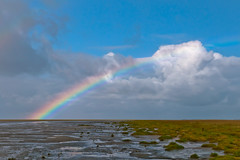 五個聯合國下的機構在1日宣布,將設置一個直接提供經濟利益的全球性藍色碳市場,給以保護海洋棲地為主的計劃,以增進海洋與海岸地區的管理。
五個聯合國下的機構在1日宣布,將設置一個直接提供經濟利益的全球性藍色碳市場,給以保護海洋棲地為主的計劃,以增進海洋與海岸地區的管理。
「海洋與海岸永續發展藍圖」表示,該機構打算與現有的國際碳市場合作,定義並實現一個藍色碳市場,來保護海洋與沿海碳匯。
海洋是溫室氣體二氧化碳的碳匯。實際上,海洋是地球上最大的活性碳匯,吸收了所有二氧化碳排放的26%。
海洋之所以成為最大碳匯的原因之一乃源自其生物泵作用,可以將海洋表面的二氧化碳移除,轉變成生物的一部分,也可經由擾動將二氧化碳移往深海。
世界上由生物所吸收的碳當中,有55%是海洋生物所完成,所以稱之為藍碳。
其中一半以上的碳是海洋植物棲地所吸收,包含紅樹林、鹽水沼澤,海草與海藻。這些植物只覆蓋了不到0.5%的海床,但是卻在調節氣候與減緩氣候變遷上扮演著重要的角色。
包括聯合國教科文組織(UNESO)、政府間海洋委員會(IOC)、聯合國開發計畫署(UNDP)、國際海事組織(IMO)以及聯合國農糧署(UNFAO)等五個通過該發展藍圖的機構警告,雖然海洋佔有地球表面的70%,其中受到保護的面積不到1%。
這些機構表示,他們將努力創造一個全球性的海洋與海岸棲地共識,與「全球藍碳基金」進行碳市場的交易。
這些機構表示,海洋以及其生態系統的關鍵角色一直被忽視。他們的目標在確保海洋以及海岸生態系統,在2012年6月將舉辦的聯合國永續發展大會(Rio+20)中不會被忽略。
他們在報告中強調,世界上主要海洋生態系統中,有60%已經退化或者被以非永續的方式利用,導致巨大的經濟與社會損失。
過去50年間,紅樹林的覆蓋面積少了30-50%,而珊瑚礁則減少了20%的覆蓋率,使許多沿海人口稠密的地區變得越來越脆弱。
海洋吸收了將近26%的大氣中二氧化碳排放量。這造成了海洋酸化,威脅到部分的浮游生物,並危及整個海洋食物鏈,仰賴海洋與海岸水域的人類生計也受到威脅。
這些機構在1日表示,「這並不是新鮮事,由於人類活動以及科技發展,導致的氣候變遷所累積的壓力加劇了這些現象。」
「位於深海的生態系其生物多樣性往往具有重大的價值,但通常都沒有被好好研究,幾乎沒有採取任何的保護。」
國際社會在聯合國「1992里約高峰會」以及「2002約翰尼斯堡高峰會」中都承諾要解決這些問題。
但聯合國的機構承認,所作的承諾仍然無效,所訂的目標也都沒有達成。無論是承諾在2015年以前將魚類數量恢復到永續的水平,或是在2012年以前設立海洋保護區網絡都沒有達到。
報告中發現,很少有國家立法減少以造成海洋死亡區域增加的陸源性海洋污染。有超過400處海洋區被列為「生物性死亡」。
報告作者指出,「要全面達成這些目標,需要由各國家、政府間組織以及國際社會作出更多的努力。」
他們表示,目前的狀況是缺乏政治意願與資源、機構的能力不足、缺乏科學數據以及市場失衡。
「綠化藍色經濟需要科學與技術的推動,」他們做出結論,「但成功取決於良好的政策施行以及有效的制度安排,因此需要來自國際社會以及世界各國與業界的承諾與資金。」
A global blue carbon market that would create direct economic gain for those who protect ocean habitats is the main feature of a plan issued today by five United Nations agencies to improve the management of the world's ocean and coastal areas.
The "Blueprint for Ocean and Coastal Sustainability" says that the agencies intend to work with existing international carbon markets to define and implement a blue carbon market for protecting marine and coastal carbon sinks.
Oceans act as sinks for the greenhouse gas carbon dioxide, CO2. In fact, the oceans are the largest active carbon sink on Earth, absorbing 26 percent of all CO2 emissions.
One reason for the oceans' big share of carbon is its biological pump, which removes carbon dioxide from the ocean surface, changing it into living matter and distributing it to the deeper water layers.
Out of all the biological carbon captured in the world, 55 percent is taken up at sea by marine living organisms, and so is called blue carbon.
At least half of this is captured by the ocean's vegetated habitats - mangroves, salt marshes, seagrasses, and seaweed. These plants cover less than 0.5 percent of the seabed, but play an important role in regulating the climate and mitigating climate change.
The five UN agencies that authored the Blueprint - UNESCO, the Intergovernmental Oceanographic Commission, the United Nations Development Programme, the International Maritime Organization, and the UN Food and Agriculture Organization - warn that although the oceans account for 70 percent of the planet's surface, only one percent of that area is protected.
The agencies say they will work to create global acceptance of ocean and coastal habitats as a new form of tradable carbon market with a "global blue carbon fund."
The critical role of oceans and their ecosystems has been overlooked, the agencies say. They aim to ensure oceans and coastal ecosystems are not neglected at the upcoming Rio+20 conference scheduled for June 2012.
Mangrove forest on the coast of Yangjiang, Guangdong, China (Photo by Leo Zhu)
Their report emphasises that 60 percent of the world's major marine ecosystems have been degraded or are being used unsustainably, resulting in huge economic and social losses.
Mangrove forests have lost 30 to 50 percent of their original cover in the last 50 years while coral reefs have lost 20 percent, increasing the vulnerability of many highly populated coastal areas.
The ocean absorbs close to 26 percent of atmospheric carbon dioxide emissions. This is causing acidification of the oceans that is already threatening some varieties of plankton and poses a threat to the entire marine food chain and the human livelihoods that depend on the oceans and coastal waters.
"Some of these phenomena are not new but are aggravated by cumulative pressures such as climate change, intensified human activity and technological advances," the agencies said today.
Breaking wave at Puerto de la Cruz, Tenerife, Canary Islands, Atlantic Ocean (Photo by Marc Pinter)
"Ecosystems situated in the deep ocean, where biodiversity and habitats often have major value, but are generally not well understood, have virtually no protection at all."
The international community pledged to tackle these challenges at the United Nations summits in Rio in 1992 and Johannesburg (in 2002.
But the commitments made there remain ineffective and their objectives have not been met, the UN agencies acknowledge. Neither the pledge to restore fish stocks to sustainable levels by 2015, nor the promise to create networks of protected marine areas by 2012 have been met.
Few countries have adopted legislation to reduce land-based marine pollution,which has led to an increase in the number of dead ocean areas, the report finds. More than 400 marine areas have been listed as "biologically dead."
"The full implementation of many of these goals and targets will require further efforts by states, intergovernmental organizations and the international community," write the authors.
They claim the present situation is the result of insufficient political will and resources, inadequate institutional capacities, insufficient scientific data and market imbalances.
"Greening the Blue Economy will be science and technology driven," they conclude. "But success will depend on sound policy processes and effective institutional arrangements and will therefore require commitment and funding from the international community as well as nations and industry."







